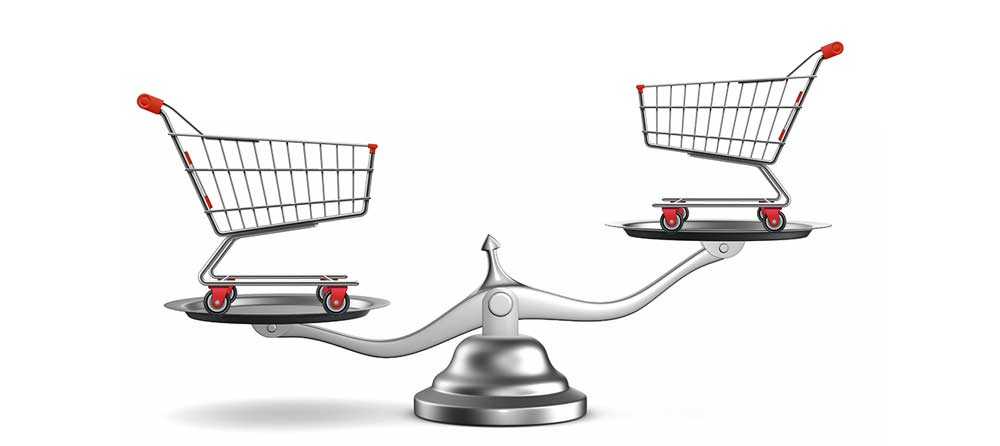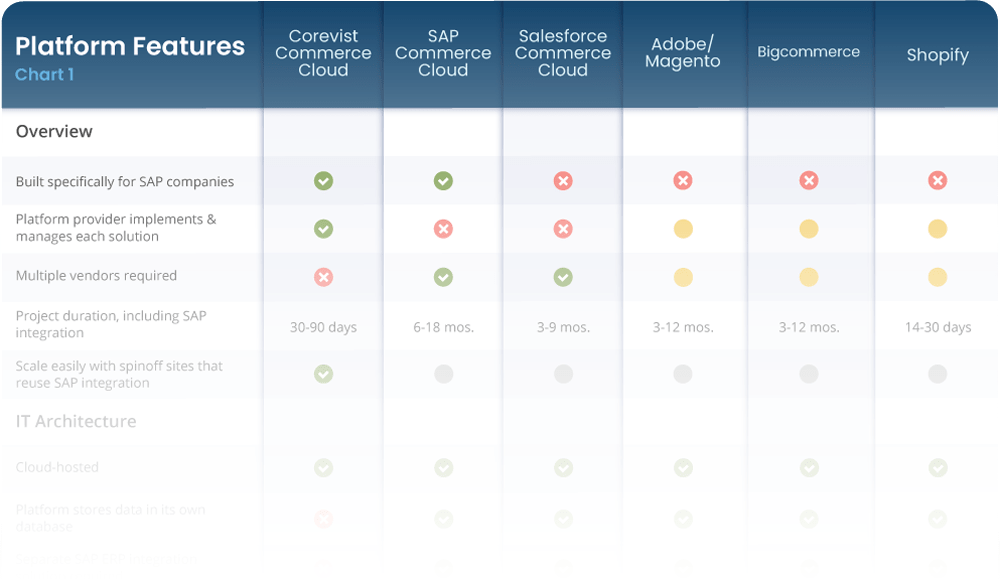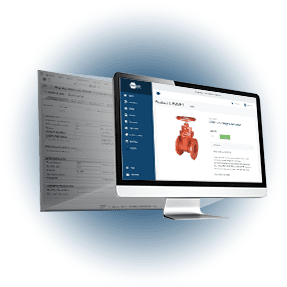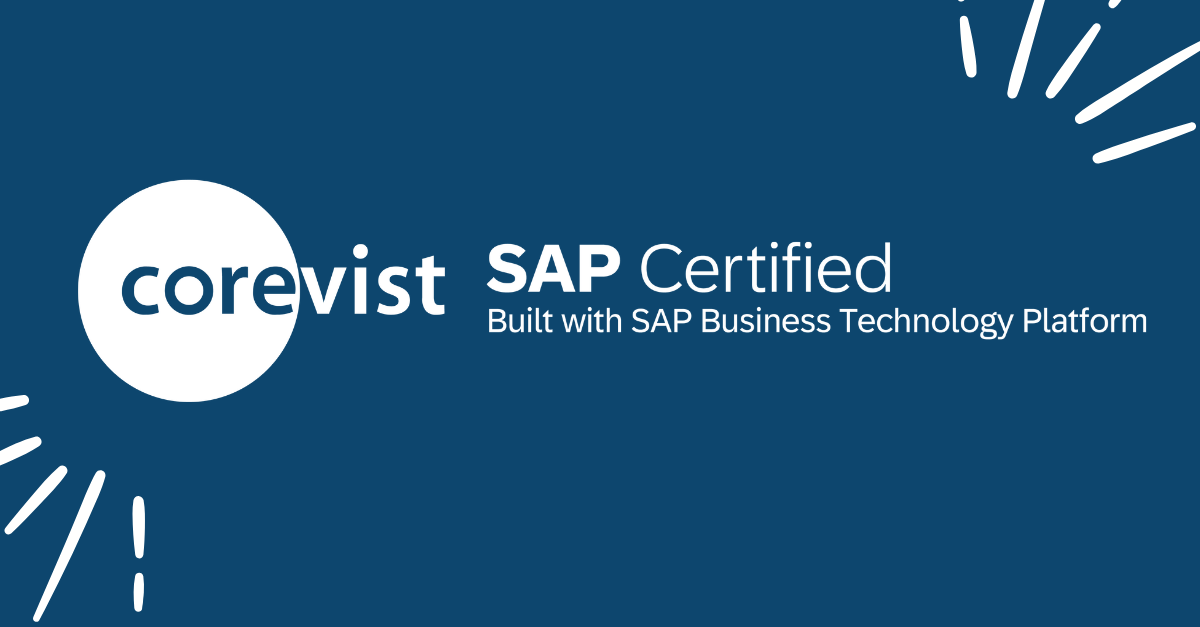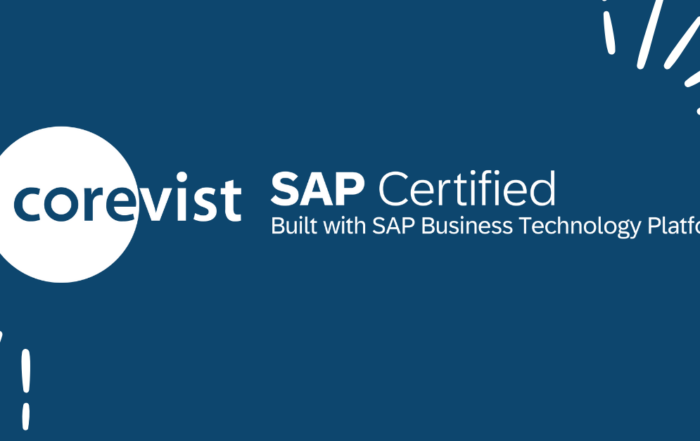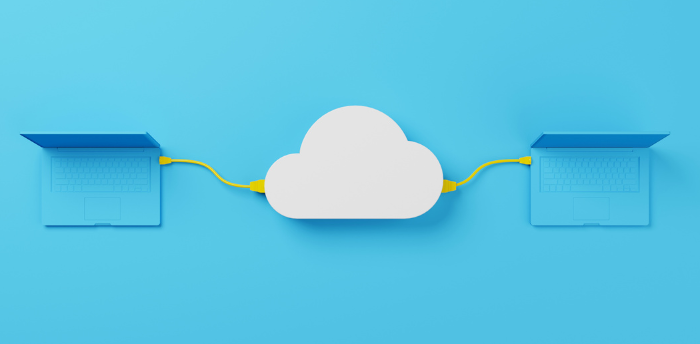Share
Author
George Anderson
Share
Originally published March 6, 2018. Refreshed July 11, 2023.
Comparing the top B2B ecommerce platforms? You’re not alone. Forrester has predicted that US B2B ecommerce sales will top $2 trillion in 2023 and $3 trillion in 2027. In that year, Forrester predicts that B2B ecommerce will account for 24% of all B2B sales in the US.
Clearly, B2B ecommerce is the name of the game. And whether you’re scoping your first B2B ecommerce project, or you’re considering switching platforms, it’s essential to understand what the market offers as you compare options.
Unfortunately, it’s hard to find real data on the nitty-gritty details of different platforms.
That’s why we put together a FREE chart comparing the top 6 B2B ecommerce platforms. Click to download the full chart:
Top 6 B2B ecommerce platforms 2023
In our B2B platform chart, we compare:
- Corevist Commerce Cloud
- SAP Commerce Cloud
- Salesforce Commerce Cloud
- Adobe/Magento
- Bigcommerce
- Shopify
While there are many other options for B2B ecommerce platforms, these are the ones that SAP companies consider most frequently.
Ready to compare? Download the chart now
Understanding the chart and comparing platforms
No doubt about it, our chart contains a lot of information. It’s important to understand the nuance behind every item in the chart.
Here’s the in-depth information behind every item in the chart.
Overview
Built specifically for SAP companies
Organizations that run on SAP ECC or S/4HANA have typically made a huge investment in their ERP system. This is where all business data lives, from customers, to products, to transactions—and everything in between.
The ERP is also the system of record for complex business rules. Every customer’s unique contract pricing lives in the ERP. Likewise, scaled pricing, minimum quantities, real-time inventory or ATP (available to promise)—it all comes from the ERP.
You could say these organizations are “ERP-first.” The ERP is the foundation of their entire business.
When an ERP-first organization looks for a B2B ecommerce solution, the question of ERP integration becomes crucial. How will B2B ecommerce share data with SAP ERP?
In our chart, Corevist Commerce Cloud and SAP Commerce Cloud are the only two platforms that were built specifically for SAP companies. This becomes important when we get to ERP integration (see below).
Platform provider implements & manages each solution
Some B2B ecommerce platform vendors don’t implement the solutions that run on their platform. Others offer the option to use the platform provider as the implementation vendor, or to find another partner.
Multiple vendors required
This is an extension of the previous item. In a nutshell, this item asks, “Can you launch the B2B ecommerce solution through a single vendor? Or do you need to engage multiple vendors?” Reducing vendor count is a great way to speed up a project and reduce the complexity that your organization has to handle. As you compare B2B ecommerce platforms, it’s worth considering how many vendors you’ll need to implement a given platform.
Project duration, including SAP integration
How long will it take to implement your B2B ecommerce solution? How does SAP ERP integration impact that timeline? This is an essential consideration. Note that Corevist Commerce Cloud launches in 30-90 days, depending on your chosen package—with SAP integration included. This is significantly faster than every alternative. Download the chart now to get all the details.
Scale easily with spinoff sites that reuse SAP integration
Some organizations need more than one B2B ecommerce storefront, with every storefront integrated to the same ERP system (or to an ERP system that’s configured similarly). The question here is whether each B2B ecommerce platform provides this easy scalability without requiring a duplicate investment in ERP integration infrastructure. The answer may surprise you.
IT Architecture
This is an essential consideration as you compare B2B ecommerce platforms. Who hosts the software? Who’s responsible for upgrading and maintaining it? What responsibility for infrastructure will your organization take on if you use a certain platform?
Here are all the factors that the chart provides for comparing platforms in terms of architecture.
Cloud-hosted
Is the solution hosted in the cloud, or will you need your own servers to run it? Modern solutions are cloud-native, and we’re glad to report that every platform in the chart is cloud-hosted. Comparing them on this point is easy!
Platform stores data in its own database
When it comes to ERP integration, it’s worth considering the risks of duplicating and synchronizing data. Any time you copy essential business data or logic, rather than reading and writing it directly, you risk creating data governance problems. You’ll want to look closely at how each B2B ecommerce platform handles your data.
Separate SAP ERP integration solution required
Will your chosen B2B ecommerce platform require a third-party integration to your ERP? If so, this will drive up the cost, complexity, and risk of your project. Use the chart to see how the leading platforms compare in terms of ERP integration capabilities.
Built on real-time SAP ERP integration
For SAP companies, the question of ERP integration is essential. Our chart shows which platforms include real-time SAP ERP integration—and which don’t.
If you’re on ECC or S/4HANA, you’ll also want to consider whether your preferred B2B ecommerce platform includes an SAP-certified integration for that specific ERP.
(Hint: Corevist Commerce Cloud includes an SAP-certified integration for ECC or S/4HANA.)
Cost
Cost forecasting for B2B ecommerce is a complex undertaking. It’s not enough to consider licensing and hosting costs. Implementation costs, FTEs required, transaction fees—there are many components.
Use our free chart to compare the top 6 platforms in terms of cost. Here’s what we cover in the chart.
FTEs required during implementation
How many FTEs will your organization need to supply during the implementation? This is a critical, and often overlooked, cost factor.
Implementation cost
What will your implementation partner charge to build, refine, and launch the solution? You may be surprised at how the different platforms stack up.
FTEs required to support
After GoLive, how many FTEs will your organization need to provide to support B2B ecommerce? This information is hard to find for different platforms. Use our chart to get a sense of how different platforms will impact your ongoing IT staffing needs.
Annual cost of ownership (excluding FTEs)
Aside from staffing costs, how much will you spend per year to run a given B2B ecommerce platform? Our chart compares the top 6 platforms in terms of annual cost of ownership.
Transaction fees
Not every B2B ecommerce platform in our chart charges transaction fees—but two of them do. Make sure you understand the potential impact if you choose one of these platforms. Download the chart now to get the details.
Out-of-the-box features integrated to SAP ERP
Here’s an essential point of comparison. Does the B2B ecommerce platform include SAP-integrated features, right out of the box? This is a critical question for SAP companies—particularly those with complex business rules defined in the ERP. Our chart covers tons of features by platform and answers the crucial question of whether each feature is integrated to SAP. Here’s what we cover in the chart.
B2B ecommerce capabilities
- Real-time, customer-specific price & inventory from SAP
- SKU-based order entry with conversion to SAP material number
- Product catalog with rich content (PIM ready)
- SAP-integrated configurable products (SKU in SAP)
- Related products
- Order simulated against SAP business rules in real time
- Selection of shipping options
- Credit card checkout
- Drop shipping
- Error-free orders post to SAP instantly
- Saved carts
- Upload cart from CSV file
- Quote creation integrated to SAP
- Convert quote to order, integrated to SAP
- Change quotes and orders
Tracking capabilities
- Full order history from SAP, all channels included (EDI, phone, email…)
- Order details & status for every order in SAP
- Full quote history & status from SAP
- Real-time shipment tracking with major carrier integration
- Order, delivery, and billing outputs from SAP
- Display of custom ABAP reports from SAP
- Full inventory history from SAP
- Invoice status and detail from SAP
- Payment history from SAP
As you can see, there’s a huge range of features that may (or may not) be integrated to SAP ERP out of the box. Download the chart now to compare all 6 platforms in terms of SAP-integrated features.
Add-ons available, integrated to SAP ERP
Some B2B ecommerce platforms may not include every possible feature in the out-of-the-box package. Specialized functionality may require an add-on. The question here is whether those add-ons are automatically integrated to SAP ERP.
Here are the B2B ecommerce add-ons that we compare in the chart.
Sales order automation
Not every customer will use the B2B ecommerce platform to place orders. Some customers may still send orders via email. Sales order automation solves this problem. It uses AI to analyze incoming email orders, posts them to the ERP if they are error-free, and routes them to customer service if the orders contain errors.
Digital invoice payments
Can your B2B ecommerce customers pay off invoices online—in the B2B ecommerce portal? Do their payments and account updates post to SAP instantly? Our chart compares the top 6 platforms from this perspective.
Separate D2C storefront support
B2B organizations often face complex challenges in terms of sales channels. For those that want to launch a D2C (direct to consumer) channel alongside B2B ecommerce, it’s important to ask how a given platform can support that initiative.
ERP integration continuity
This question is specifically for SAP companies. For those that are on SAP ECC and are migrating to S/4HANA, how will this massive shift affect B2B ecommerce?
The good news is that one platform follows you easily from ECC to S/4HANA. You can literally launch the integrated solution today on ECC and transfer that investment to S/4HANA with minimal heavy lifting. Download the chart to get all the details.
The takeaway: Look at SAP integration when you compare platforms
For SAP companies, the ERP integration can make or break B2B ecommerce. If customers can’t get accurate contract pricing, personalized inventory, and full account history in the portal, then the solution isn’t really working.
That’s why Corevist Commerce Cloud includes prebuilt, real-time integration for ECC or S/4HANA. Your B2B ecommerce solution always reflects the right data and logic, for every customer—automatically.
Because Corevist is a managed, cloud-hosted solution, you get it all without taking on any new responsibility for the technology. Your IT team simply maintains SAP ERP as they always have, and Corevist automatically displays the right information to every customer.

